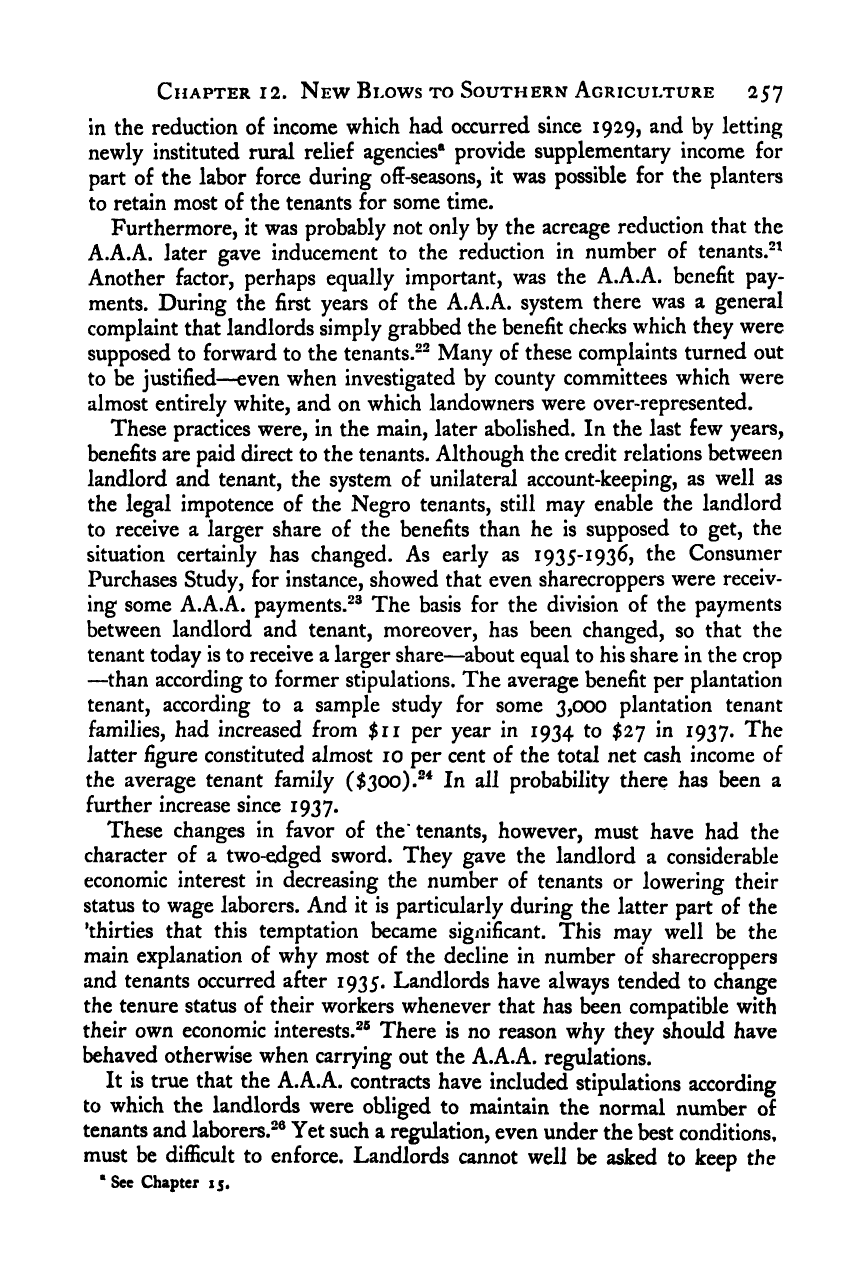Note: Gunnar Myrdal died in 1987, less than 70 years ago. Therefore, this work is protected by copyright, restricting your legal rights to reproduce it. However, you are welcome to view it on screen, as you do now. Read more about copyright.
Full resolution (TIFF) - On this page / på denna sida - IV. Economics - 12. New Blows to Southern Agriculture During the ’Thirties: Trends and Policies - 4. A.A.A. and the Negro

<< prev. page << föreg. sida << >> nästa sida >> next page >>
Below is the raw OCR text
from the above scanned image.
Do you see an error? Proofread the page now!
Här nedan syns maskintolkade texten från faksimilbilden ovan.
Ser du något fel? Korrekturläs sidan nu!
This page has never been proofread. / Denna sida har aldrig korrekturlästs.
Chapter i2. New Blows to Southern Agriculture 257
in the reduction of income which had occurred since 1929, and by letting
newly instituted rural relief agencies*^ provide supplementary income for
part of the labor force during off-seasons, it was possible for the planters
to retain most of the tenants for some time.
Furthermore, it was probably not only by the acreage reduction that the
A.A.A. later gave inducement to the reduction in number of tenants.*’
Another factor, perhaps equally important, was the A.A.A. benefit pay-
ments. During the first years of the A.A.A. system there was a general
complaint that landlords simply grabbed the benefit checks which they were
supposed to forward to the tenants.*^ Many of these complaints turned out
to be justified—even when investigated by county committees which were
almost entirely white, and on which landowners were over-represented.
These practices were, in the main, later abolished. In the last few years,
benefits are paid direct to the tenants. Although the credit relations between
landlord and tenant, the system of unilateral account-keeping, as well as
the legal impotence of the Negro tenants, still may enable the landlord
to receive a larger share of the benefits than he is supposed to get, the
situation certainly has changed. As early as 1935-1936, the Consumer
Purchases Study, for instance, showed that even sharecroppers were receiv-
ing some A.A.A. payments.^^ The basis for the division of the payments
between landlord and tenant, moreover, has been changed, so that the
tenant today is to receive a larger share—about equal to his share in the crop
—than according to former stipulations. The average benefit per plantation
tenant, according to a sample study for some 3,000 plantation tenant
families, had increased from $ii per year in 1934 to $27 in 1937. The
latter figure constituted almost 10 per cent of the total net cash income of
the average tenant family ($300).^* In all probability there has been a
further increase since 1937.
These changes in favor of the’ tenants, however, must have had the
character of a two-edged sword. They gave the landlord a considerable
economic interest in decreasing the number of tenants or lowering their
status to wage laborers. And it is particularly during the latter part of the
^thirties that this temptation became significant. This may well be the
main explanation of why most of the decline in number of sharecroppers
and tenants occurred after 1935. Landlords have always tended to change
the tenure status of their workers whenever that has been compatible with
their own economic interests.^® There is no reason why they should have
behaved otherwise when carrying out the A.A.A. regulations.
It is true that the A.A.A. contracts have included stipulations according
to which the landlords were obliged to maintain the normal number of
tenants and laborers.^® Yet such a regulation, even under the best conditions,
must be difficult to enforce. Landlords cannot well be asked to keep the
• See Chapter 15,
<< prev. page << föreg. sida << >> nästa sida >> next page >>